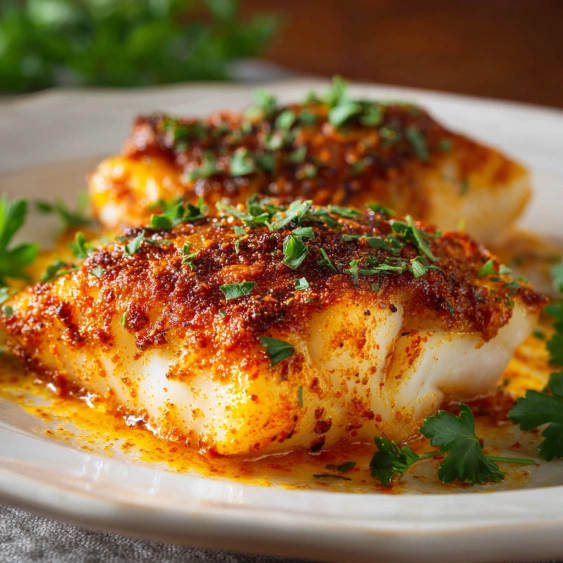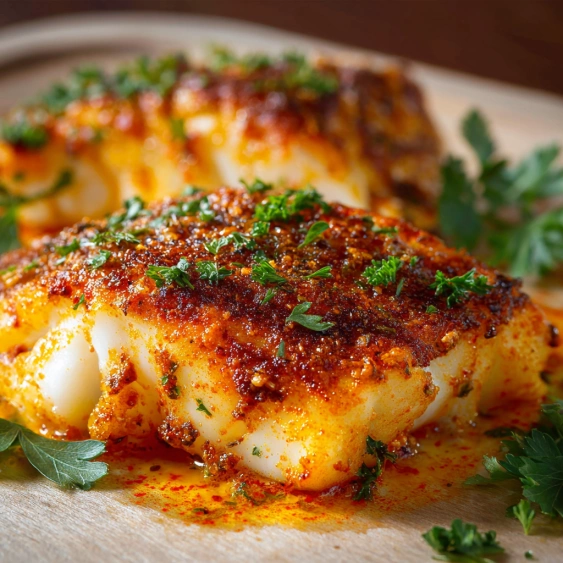 Pin it
Pin it
This broiled cod with paprika recipe transforms a simple white fish into a flavorful, protein-packed dinner that's both low in calories and carbohydrates. Perfect for busy weeknights, this dish delivers maximum flavor with minimal effort while keeping your healthy eating goals on track.
I discovered this cooking method when trying to make fish more appealing for my family who weren't big seafood fans. The simple paprika rub created such a flavorful crust that even my pickiest eaters requested seconds. Now it's our go-to healthy dinner option when we need something quick but satisfying.
Ingredients
- 2 pounds cod fillets: Fresh is best but frozen works well when properly thawed
- 1 tablespoon olive oil: Helps seasonings adhere and keeps fish moist
- 1 ¼ teaspoons paprika: Provides beautiful color and mild smoky flavor
- ½ teaspoon onion powder: Adds aromatic depth without texture
- ½ teaspoon garlic powder: Gives savory note without risk of burning
- ⅓ teaspoon salt: Enhances all flavors without making dish too salty
- Juice from ½ lemon: Brightens flavors and helps tenderize the fish
- 1 tablespoon salted butter: Creates rich finish and helps fish brown beautifully
Step-by-Step Instructions
- Prep Your Oven:
- Move an oven rack to the highest position about 4 inches from heat source. Preheat the broiler to medium setting at 500 degrees F. This high position allows quick browning without overcooking the delicate fish.
- Prepare Baking Surface:
- Line a half sheet pan with foil and spray with cooking spray. This prevents sticking and makes cleanup effortless. The foil also helps reflect heat for more even cooking.
- Prepare The Fish:
- Rinse cod lightly and check thoroughly for any pin bones by running your fingers along the flesh. Pat completely dry with paper towels as moisture prevents proper browning. Cut larger pieces into portion sizes using kitchen scissors for clean cuts without tearing.
- Season The Fish:
- Mix paprika, garlic powder, onion powder and salt in a small bowl until fully combined. Drizzle each piece with olive oil and brush to coat all surfaces. Apply seasoning blend generously to all pieces, then gently rub it in to ensure it adheres well. This creates a flavorful crust that seals in moisture.
- Add Finishing Touches:
- Squeeze fresh lemon juice evenly over all pieces. Place small pieces of butter on top of each fillet. The butter melts during cooking, creating a rich sauce that mingles with the spices.
- Broil To Perfection:
- Broil thin fillets for approximately 6 minutes and thicker pieces for about 8 minutes. Watch carefully as broiling can quickly go from perfect to overdone. The fish is ready when it flakes easily with a fork and has a slight crust on top.
- Serve With Care:
- Plate the fish and spoon the flavorful pan juices over the top. This sauce contains concentrated flavor from the seasonings, butter and natural fish juices that shouldn't go to waste.
 Pin it
Pin it
Paprika is the star ingredient in this dish. I prefer using Spanish paprika for its vibrant color and complex flavor profile. My grandmother taught me that paprika needs fat to fully release its flavors, which is why the combination of olive oil and butter makes such a difference in this simple preparation.
Perfect Pairings
This broiled cod shines alongside roasted vegetables like asparagus or broccoli that can cook at the same time on a second sheet pan. For a complete meal, consider serving with cauliflower rice for a low-carb option or a small portion of quinoa if you prefer some whole grains. The subtle flavors of the fish also complement a crisp green salad with a light vinaigrette.
Storage And Reheating
Leftover cod can be stored in an airtight container in the refrigerator for up to three days. For best results when reheating, avoid the microwave which can make fish rubbery. Instead, place in a covered baking dish in a 275°F oven just until warmed through, about 10 minutes. The gentle heat preserves the moisture and texture of the fish.
Making It Your Own
While this recipe is perfect as written, you can easily adapt it to your taste preferences. Try adding a pinch of cayenne for heat, swap in dried herbs like thyme or dill, or create a Mediterranean version with oregano and lemon zest. This cooking method works beautifully with other white fish varieties too, including haddock, pollock, or tilapia, though cooking times may vary slightly based on thickness.
 Pin it
Pin it
Frequently Asked Questions
- → How do I know when the cod is fully cooked?
The cod is done when you can easily flake it with a fork. Thin pieces typically take about 6 minutes under the broiler, while thicker pieces need around 8 minutes. If the fish begins to darken too quickly but isn't cooked through, move it to the center rack while maintaining the broil setting.
- → Can I use a different type of fish for this preparation?
Yes, this preparation works well with other white fish varieties like haddock, pollock, or tilapia. You may need to adjust cooking times slightly depending on the thickness of the fillets.
- → What can I serve with this broiled cod?
This cod pairs wonderfully with roasted vegetables, a light salad, cauliflower rice, or steamed greens for a complete low-carb meal. It's also excellent served on a brioche bun as a sandwich, in lettuce wraps, or as part of fish tacos.
- → Can I use smoked paprika instead of regular paprika?
Yes, smoked paprika can be substituted, but reduce the amount to 1 teaspoon instead of 1¼ teaspoons as noted in the ingredients. Smoked paprika has a stronger, more robust flavor profile.
- → How do I store leftover cod and how long will it keep?
Store any leftover broiled cod in an airtight container in the refrigerator for up to three days. Reheat gently in the microwave or in a skillet over medium-low heat until just warmed through to avoid drying out the fish.
- → Can this dish be prepared in advance?
While it's best served fresh, you can prepare the seasoning mix and cut the fish ahead of time. Store the seasoning at room temperature and the prepared fish in the refrigerator until ready to cook, then proceed with the olive oil, seasoning, and broiling steps just before serving.
